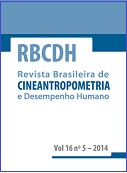Anthropometric indicators associated with hypertriglyceridemia in the prediction of visceral fat
DOI:
https://doi.org/10.1590/1980-0037.2014v16n5p485Abstract
The accumulation of visceral fat is strongly associated with cardiometabolic changes. Alternative methods, such as the association between anthropometric indicators and hypertriglyceridemia, are used as the best estimate for the accumulation of visceral fat, preventing cardiovascular diseases. The aim of this study was to evaluate the association of anthropometric indicators with hypertriglyceridemia in the prediction of visceral fat in men and women. This was a cross-sectional study conducted with 192 individuals, of both genders, submitted to anthropometric evaluation (sagittal abdominal diameter [SAD], waist circumference [WC], and waist-hip ratio [WHR]), serum dosage of triglycerides (TG), and computed tomography scan, in order to measure the visceral adipose tissue (VAT) area. Descriptive analysis, Pearson’s Correlation, and multiple linear regression were performed. Anthropometric indicators had high correlation with the VAT area (p=0.000). Regardless of serum TG levels, individuals with high values of anthropometric indicators had excess VAT area (p<0.05). For every centimeter increased in SAD, there was an average increase of 12.46 cm² in the VAT area. The study showed that both SAD and WC were good indicators to explain the variability in the VAT area, independently of changes in TG levels, making it possible to identify individuals with a risk of developing cardiovascular diseases.



